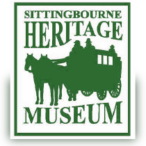Sittingbourne Cattle / Livestock Market
In the 19th century the Bull Inn and its yard with the meadow behind it, was a well-established gathering place for Sittingbourne’s agricultural community. In the late 18 century the Tonge family owned the Inn, and the meadow at the back was owned by Thomas Chittenden, a butcher. He had acquired it from the Tyldens of Milstead who in turn had acquired it from the earliest recorded owners – the Adyes of Down Court, Doddington. There on Mondays, generations of local farmers, dealers and butchers met for the stock market – a free-for-all, where sellers and buyers, including butchers, haggled with each other over the sale of live and dead stock. After a spell in the Public Rooms of the former George Hotel(q.v.), the corn market was here too on Wednesdays, and then in the latter half of the century, on Fridays, in equally informal conditions, until the inauguration of the town’s Corn Exchange in 1859.
Then, in the 1890s, a fundamental change came about, thanks to one man, Francis Austen Bensted. Shortly before that, following four years training in East Kent with his uncle and cousins, the Collards, (a large family, well-known for their prowess as farmers and auctioneers,) Bensted, a Doddington man, came home.
Local advertisements in the 1880s by Collard & Prentis, auctioneers, valuers and estate agents, of 77 High Street, Sittingbourne, offer a tantalising link. In 1885 Bensted wrote to his father from his uncle’s farm at Monkton that he had been offered by “Charles Collard’s son” (of whom there were four) a partnership as “cattle salesman” adding “of course I must come home to live”. The Collards’ auction business had centred since the 18 century on Little Barton farm at Canterbury, but Bensted’s letter makes clear that the partnership offered was near his Doddington home – presumably at Collard & Prentis who had been established at Sittingbourne for at least three years before that.
Instead of simple haggling, the auction sales, which Collard and Prentis may have initiated, had brought order to the process. It was soon obvious that, by pitting several buyers against each other, rather than merely haggling one to one, a better price could often be achieved. The auctioneer took a commission on the sale price, the business thrived and disorderly haggling died out.
Within a few years of completing his training, though still in his twenties, Bensted struck out on his own, re-constituting and raising the status of the livestock market, with himself as the sole auctioneer. In 1892, building on the long-established practice of Tuesday markets, and pre-empting them, he initiated his own auction sales on the day prior – alternate Mondays – at 11.30am.
The Corn Exchange process took place every Friday between 3 and 5pm. Though still at the Corn Exchange nearly 30 years after the building became the Town Hall, the corn market, in 1906, came back “home” to the more informal and congenial surroundings at the Bull – in line with one of the proposals made at the exploratory meeting in the Public Rooms in 1858 before that “noble pile”, the Corn Exchange, was built. It remained at The Bull until it closed around 20 years later.
By 1931 whilst the stock market was still held fortnightly on Mondays, the poultry, eggs and farm-produce market was held by Bensted every other Wednesday.
This market was not part of the Bensted operation but its transfer helped to consolidate the Bull Hotel and the market site as the gathering place for the local farming community – and the business folk and tradesmen of our town who depended upon it. The Bull retained a decidedly rural atmosphere even after the second world war; the market came right up to the back door and, even then, animals were sometimes driven on foot through the streets of our town.
The Bensteds
On a piece of land which Mr Bensted bought beside the main market site on the Bull meadow, there was erected a wooden hut (perhaps an ex-army one from a local camp, like Gore Court). There on Wednesdays, between the wars, were conducted auctions of eggs, rabbits, poultry and other farm produce, but the food restrictions following the outbreak of war in 1939 brought these sales to an end.
Other auctions, such as cherry crops and occasional sales of property, were also held in the Market Building (the Egg Hut, as it was known informally). It was rented out to other auctioneers – not direct competitors in the agricultural field, but urban ones like Hedley Peters and A. J. Turner – to conduct their own auctions. Sales of chattels, dependent upon the rostrum performance of the auctioneer, provided free entertainment – a welcome addition to the life of our community.
Sometimes auctions of property – land and buildings – requiring quieter, more serious concentration, were held in more formal accommodation, such as the dining room of the Bull Hotel or the Masonic Hall in Albany Street, behind Mr Bensted’s garden.
















